[search-this-area]
Refine search
No keyword found to refine search
keywords
Places
Names
|
Contact sheet
List
Slide show
51 documents found
| 1 |
Documents per page :
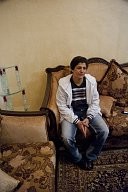
Palestinian women.
Chris Huby / Le Pictorium
LePictorium_0053485.jpg
Safia, the ex-terrorist. - - She has just been released after 8 years in prison. A very bad period for this lady who has only nasty stories to told: daily beatings, administered drugs, all this was its everyday life a few weeks ago. - - Furthermore, she discovered her cancer to the stomach 4 years ago. - - Imprisoned for the preparation of an attempt, she is a part of the recently thousand released Palestinians. She does not regret her ideas - she had her reason to do it - even if today she will not do it any more. - - Right now, she's following a long treatment for her disease. She also explains what she lived in the Israeli prisons to everybody.

Palestinian women.
Chris Huby / Le Pictorium
LePictorium_0053492.jpg
A young girl and her mother; victims of the brutalities and pressions made by Tsahal in the village of Azzun. - Indeed, the Israeli soldiers were looking for conspirators in all the houses and questioned violently the inhabitants.
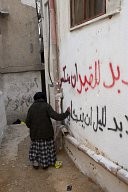
Palestinian women.
Chris Huby / Le Pictorium
LePictorium_0053500.jpg
Women in Ein Beit Al-Ma' ; a Refugee Camp called camp N°1, at the west of Nablus city; established in 1950 on 45 dunums beside the main Nablus/Jenin road, and within the municipal boundaries of Nablus. Following the Israeli redeployment in 1995, the camp fell under Palestinian Authority control in "Area A".
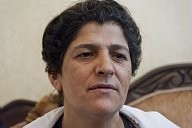
Palestinian women.
Chris Huby / Le Pictorium
LePictorium_0053486.jpg
Safia, the ex-terrorist. - - She has just been released after 8 years in prison. A very bad period for this lady who has only nasty stories to told: daily beatings, administered drugs, all this was its everyday life a few weeks ago. - - Furthermore, she discovered her cancer to the stomach 4 years ago. - - Imprisoned for the preparation of an attempt, she is a part of the recently thousand released Palestinians. She does not regret her ideas - she had her reason to do it - even if today she will not do it any more. - - Right now, she's following a long treatment for her disease. She also explains what she lived in the Israeli prisons to everybody.

Palestinian women.
Chris Huby / Le Pictorium
LePictorium_0053494.jpg
Portrait of Djamila; in the refugee camp of Balata.
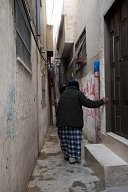
Palestinian women.
Chris Huby / Le Pictorium
LePictorium_0053501.jpg
Women in Ein Beit Al-Ma' ; a Refugee Camp called camp N°1, at the west of Nablus city; established in 1950 on 45 dunums beside the main Nablus/Jenin road, and within the municipal boundaries of Nablus. Following the Israeli redeployment in 1995, the camp fell under Palestinian Authority control in "Area A".
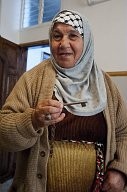
Palestinian women.
Chris Huby / Le Pictorium
LePictorium_0053495.jpg
Djamila lives in the refugee camp of Balata and keeps the key of her house lost in Jaffa as a symbol.

Palestinian women.
Chris Huby / Le Pictorium
LePictorium_0053499.jpg
Portrait of Djamila, in the refugee camp of Balata. - - It is a Palestinian refugee camp established in the northern West Bank in 1950, adjacent to the city of Nablus. It is the largest refugee camp in the West Bank. Balata Camp is densely populated with 30,000 residents in an area of 0.25 square kilometers. - - Djamila is a member the Palestinians' first refugees wave, the one who left in 1948. In the hand, the famous Palestinian key symbol of its house lost in Jaffa.

Palestinian women.
Chris Huby / Le Pictorium
LePictorium_0053487.jpg
Safia, the ex-terrorist. - - She has just been released after 8 years in prison. A very bad period for this lady who has only nasty stories to told: daily beatings, administered drugs, all this was its everyday life a few weeks ago. - - Furthermore, she discovered her cancer to the stomach 4 years ago. - - Imprisoned for the preparation of an attempt, she is a part of the recently thousand released Palestinians. She does not regret her ideas - she had her reason to do it - even if today she will not do it any more. - - Right now, she's following a long treatment for her disease. She also explains what she lived in the Israeli prisons to everybody.
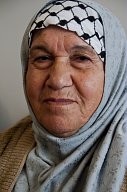
Palestinian women.
Chris Huby / Le Pictorium
LePictorium_0053496.jpg
Portrait of Djamila; Balata Camp.

Palestinian women.
Chris Huby / Le Pictorium
LePictorium_0053493.jpg
A young girl; victim of the brutalities and pressions made by Tsahal in the village of Azzun. - Indeed, the Israeli soldiers were looking for conspirators in all the houses and questioned violently the inhabitants.

Palestinian women.
Chris Huby / Le Pictorium
LePictorium_0053497.jpg
Portrait of Djamila, in the refugee camp of Balata. - Djamila is a member the Palestinians' first refugees wave, the one who left in 1948. In her hand, she keeps the key of her house, lost in Jaffa.
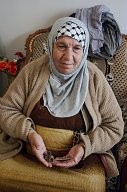
Palestinian women.
Chris Huby / Le Pictorium
LePictorium_0053498.jpg
Portrait of Djamila, in the refugee camp of Balata. - In her hand, she keeps the key of her house, lost in Jaffa. - Balata is a Palestinian refugee camp established in the northern West Bank in 1950, adjacent to the city of Nablus. It is the largest refugee camp in the West Bank. Balata Camp is densely populated with 30,000 residents in an area of 0.25 square kilometers.

Palestinian women.
Chris Huby / Le Pictorium
LePictorium_0053502.jpg
A woman in the street of Balata Camp (a Palestinian refugee camp established in the northern West Bank in 1950, adjacent to the city of Nablus)

Palestinian women.
Chris Huby / Le Pictorium
LePictorium_0053503.jpg
A woman in the street of Balata Camp (a Palestinian refugee camp established in the northern West Bank in 1950, adjacent to the city of Nablus)
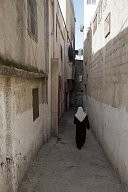
Palestinian women.
Chris Huby / Le Pictorium
LePictorium_0053504.jpg
Women in Ein Beit Al-Ma', Refugee Camp N°1.
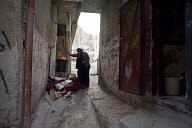
Palestinian women.
Chris Huby / Le Pictorium
LePictorium_0053506.jpg
An old woman in a street of Ein Beit Al-Ma' camp. - - 'Ein Beit el Ma also known as "Camp No. 1" is a Palestinian refugee camp established in the northern West Bank in 1950, adjacent to the city of Nablus. - Following the Israeli redeployment in 1995, the camp fell under Palestinian Authority control in "Area A". The camp is very cramped, there is serious overcrowding, and the narrow alleys are in desperate need of repair. During funerals, the deceased are usually passed through windows from one shelter to another in order to reach the camp's main street. - - A serious outbreak of diarrhoea hospitalised several hundred camp residents in the summer of 1998. Contaminated municipal water supplies was the cause of the epidemic and UNRWA's health staff worked day and night to treat the sick and to take patients to clinics and hospitals in other parts of the West Bank. - - 18 September 2007, Israeli Defense Forces (IDF) and Border Police entered 'Ein Beit el Ma Refugee Camp. The entire camp population of approximately 5,000 people was placed under complete curfew for three days. The IDF entered the camp with the stated aim of disarming militant cells in the camp. After initial clashes between IDF troops and Palestinian militants inside the camp, the IDF began house-to-house search and an arrest campaign. - Over the course of the three days there were two Palestinian fatalities and 25 injuries reported, including two children and one woman. In addition, one IDF soldier was killed and five were injured including 4 soldiers who were injured when a tear gas canister exploded prematurely inside their armoured vehicle.
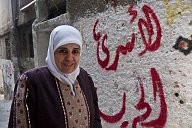
Palestinian women.
Chris Huby / Le Pictorium
LePictorium_0053505.jpg
Women in Ein Beit Al-Ma, a refugee Camp, west of Nablus city and established in 1950 on 45 dunums beside the main Nablus/Jenin road, and within the municipal boundaries of Nablus. Following the Israeli redeployment in 1995, the camp fell under Palestinian Authority control in "Area A". The camp is very cramped, there is serious overcrowding, and the narrow alleys are in desperate need of repair. During funerals, the deceased are usually passed through windows from one shelter to another in order to reach the camp's main street. - - A serious outbreak of diarrhoea hospitalised several hundred camp residents in the summer of 1998. Contaminated municipal water supplies was the cause of the epidemic and UNRWA's health staff worked day and night to treat the sick and to take patients to clinics and hospitals in other parts of the West Bank. - - 18 September 2007, Israeli Defense Forces (IDF) and Border Police entered 'Ein Beit el Ma Refugee Camp. The entire camp population of approximately 5,000 people was placed under complete curfew for three days. The IDF entered the camp with the stated aim of disarming militant cells in the camp. After initial clashes between IDF troops and Palestinian militants inside the camp, the IDF began house-to-house search and an arrest campaign. - - Over the course of the three days there were two Palestinian fatalities and 25 injuries reported, including two children and one woman. In addition, one IDF soldier was killed and five were injured including 4 soldiers who were injured when a tear gas canister exploded prematurely inside their armoured vehicle.[4]
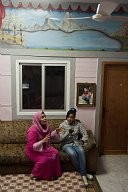
Palestinian women.
Chris Huby / Le Pictorium
LePictorium_0053507.jpg
Hawa and her daughter Ibtissem. - Israeli soldiers entered the chamber of the young girl a few years ago by destroying the wall from the nearby apartment. - - It is the practice they used during the Second Intifada to track down the terrorists. Many victims of these methods remained traumatized since. Ibtissem is one of them, she has difficulty to stay alone and her results at the school are catastrophic.

Palestinian women.
Chris Huby / Le Pictorium
LePictorium_0053508.jpg
Hawa and her daughter Ibtissem. - Israeli soldiers entered in the room of the young girl and destroyed the wall from the nearby apartment. - - A bad habit they practice since he Second Intifada to track down the terrorists. Many victims of these methods remained traumatized since. Ibtissem is one of them, she has difficulty to stay alone and her results at the school are catastrophic.
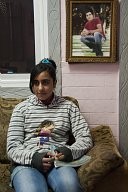
Palestinian women.
Chris Huby / Le Pictorium
LePictorium_0053509.jpg
Palestinian teenager; an other victim of the israeli pressions. - Indeed, Tsahal came into her parent's apartment and destroyed the walls. -
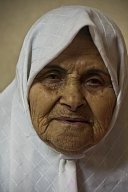
Palestinian women.
Chris Huby / Le Pictorium
LePictorium_0053512.jpg
Portrait of Hawa's mother and grandmother of Ibtissem. Deaf and old, she lives with all her family (10 persons) in a 60 square meters apartement.

Palestinian women.
Chris Huby / Le Pictorium
LePictorium_0053511.jpg
Hawa and her last daughter. - - Israeli soldiers came into the apartment and destroyed the walls of the bedrooms. - A common practice that they're using since the " Second Intifada" to track down the terrorists. - Many victims of these methods are still traumatize. -
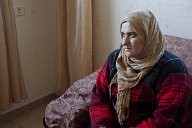
Palestinian women.
Chris Huby / Le Pictorium
LePictorium_0053491.jpg
Raya is a mother of 4 children. Her family suffered a violent shock by the Israeli settlers in the middle of the night. - They were armed and threatened the family, asking them to leave immediately. - Doctors and psychologists take care of the trauma since this terrible night.
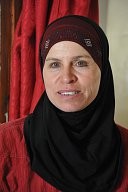
Palestinian women.
Chris Huby / Le Pictorium
LePictorium_0053513.jpg
Portrait of Manal Tamimi, resident of Nabi Salih, a small Palestinian village of over 530 in the Ramallah and al-Bireh Governorate in the central West Bank.
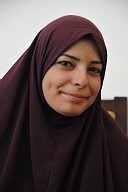
Palestinian women.
Chris Huby / Le Pictorium
LePictorium_0053514.jpg
Portrait of Leila, resident of Nabi Salih, a small Palestinian village of over 530 in the Ramallah and al-Bireh Governorate in the central West Bank.

Palestinian women.
Chris Huby / Le Pictorium
LePictorium_0053515.jpg
Mahbouba is doctor in Askar camp. She takes care of autistic children, more and more numerous in the country.
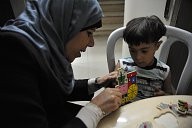
Palestinian women.
Chris Huby / Le Pictorium
LePictorium_0053516.jpg
Mahbouba is doctor in Askar camp; she takes care of autistic children, more and more numerous in the country.
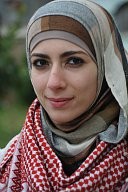
Palestinian women.
Chris Huby / Le Pictorium
LePictorium_0053488.jpg
Portrait of Mounia, a young activist. - - This young Palestinian (21 years old) goes every Fridays in villages at her own risks, under Israeli pressure, mostly Bilin and Nabi Saleh, to demonstrate peacefully with her fellow countrymen. - - Journalism student in Ramallah, she holds a political and social blog which has good repercussions around her. Drafted in English and in Arabic, it also helps the Diaspora which needs some informations. - - Her relatives may be worried about her presence in the differents villages, she never misses the Friday, the day against the Israeli occupation.

Palestinian women.
Chris Huby / Le Pictorium
LePictorium_0053490.jpg
Portrait of Manal Tamimi, resident in Nabi Saleh village. - - Manal fights since years to show to the medias the situation of her village. The waterspring of the area was stolen by the close settlement of Halamish, drying up a big part of the villages surroundings. - From television to newspapers, Manal goes even to the United States to talk about the siatuation. - - On every Friday Tsahal violently represses in the peaceful demonstrations organized by the Palestinians. Casualties are the prize of these brave marches.
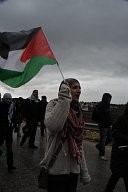
Palestinian women.
Chris Huby / Le Pictorium
LePictorium_0053489.jpg
Portrait of Mounia, a young activist. - - This young Palestinian (21 years old) goes every Fridays in villages at her own risks, under Israeli pressure, mostly Bilin and Nabi Saleh, to demonstrate peacefully with her fellow countrymen. - - Journalism student in Ramallah, she holds a political and social blog which has good repercussions around her. Drafted in English and in Arabic, it also helps the Diaspora which needs some informations. - - Her relatives may be worried about her presence in the differents villages, she never misses the Friday, the day against the Israeli occupation.

Palestinian villages under repression.
Chris Huby / Le Pictorium
LePictorium_0052343.jpg
This lady and her son live in front of the wall. Their house is between two checkpoints. There is a little door inside the wall for the exit.

Palestinian villages under repression.
Chris Huby / Le Pictorium
LePictorium_0052339.jpg
This lady and her son live in front of the wall. Their house is between two checkpoints. There is a little door inside the wall for the exit.
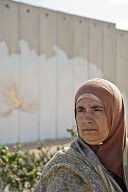
Palestinian villages under repression.
Chris Huby / Le Pictorium
LePictorium_0052340.jpg
This lady and her son live in front of the wall. Their house is between two checkpoints. There is a little door inside the wall for the exit.
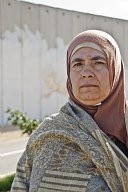
Palestinian villages under repression.
Chris Huby / Le Pictorium
LePictorium_0052341.jpg
This lady and her son live in front of the wall. Their house is between two checkpoints. There is a little door inside the wall for the exit.
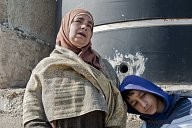
Palestinian villages under repression.
Chris Huby / Le Pictorium
LePictorium_0052342.jpg
This lady and her son live in front of the wall. Their house is between two checkpoints. There is a little door inside the wall for the exit.

Palestinian villages under repression.
Chris Huby / Le Pictorium
LePictorium_0052336.jpg
A traumatized lady
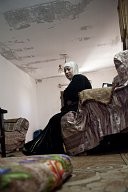
Palestinian villages under repression.
Chris Huby / Le Pictorium
LePictorium_0052337.jpg
A traumatized lady
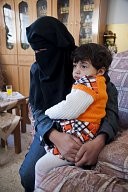
Palestinian villages under repression.
Chris Huby / Le Pictorium
LePictorium_0052286.jpg
A mother and her daughter, who lived violences in their village of Awarta. The settlers came into her house and terrorised all the family.
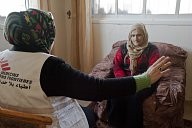
Palestinian villages under repression.
Chris Huby / Le Pictorium
LePictorium_0052327.jpg
The doctor uses breathing methods with her patient.
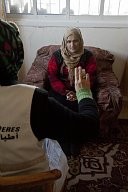
Palestinian villages under repression.
Chris Huby / Le Pictorium
LePictorium_0052328.jpg
The doctor uses breathing methods with her patient.

Palestinian villages under repression.
Chris Huby / Le Pictorium
LePictorium_0052309.jpg
The E, the X, the star of David, a lot of settlers signs on the palestinians houses. When a sign is written down on a house, it means that a lot of things happened in it.

Palestinian villages under repression.
Chris Huby / Le Pictorium
LePictorium_0052316.jpg
The E, the X, the star of David, a lot of settlers signs on the palestinians houses. When a sign is written down on a house, it means that a lot of things happened in it.

Palestinian villages under repression.
Chris Huby / Le Pictorium
LePictorium_0052292.jpg
The E, the X, the star of David, a lot of settlers signs on the palestinians houses. When a sign is written down on a house, it means that a lot of things happened in it.
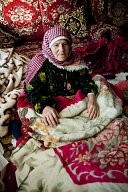
The old lady of Awarta, who sleeps only with her photos of martyrs.
Chris Huby / Le Pictorium
LePictorium_0051450.jpg
the old lady in her bed, in the middle of the rom.
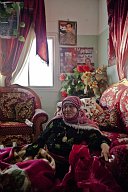
The old lady of Awarta, who sleeps only with her photos of martyrs.
Chris Huby / Le Pictorium
LePictorium_0051465.jpg
the old lady in her bed, in the middle of the rom.

Palestinian families traumatized by the coming of the Israeli colonists.
Chris Huby / Le Pictorium
LePictorium_0047071.jpg
Meïmouna saw everything since 1948. Her son was killed here a few years ago by the Israeli colonists. Nevertheless she refuses to make him a martyr, a symbol which would only be a new problem between both nations.

Palestinian families traumatized by the coming of the Israeli colonists.
Chris Huby / Le Pictorium
LePictorium_0047061.jpg
Meïmouna saw everything since 1948. Her son was killed here a few years ago by the Israeli colonists. Nevertheless she refuses to make him a martyr, a symbol which would only be a new problem between both nations.

Palestinian families traumatized by the coming of the Israeli colonists.
Chris Huby / Le Pictorium
LePictorium_0047062.jpg
Meïmouna saw everything since 1948. Her son was killed here a few years ago by the Israeli colonists. Nevertheless she refuses to make him a martyr, a symbol which would only be a new problem between both nations.

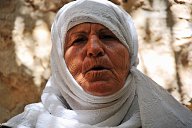 Women of Palestine
Women of Palestine

